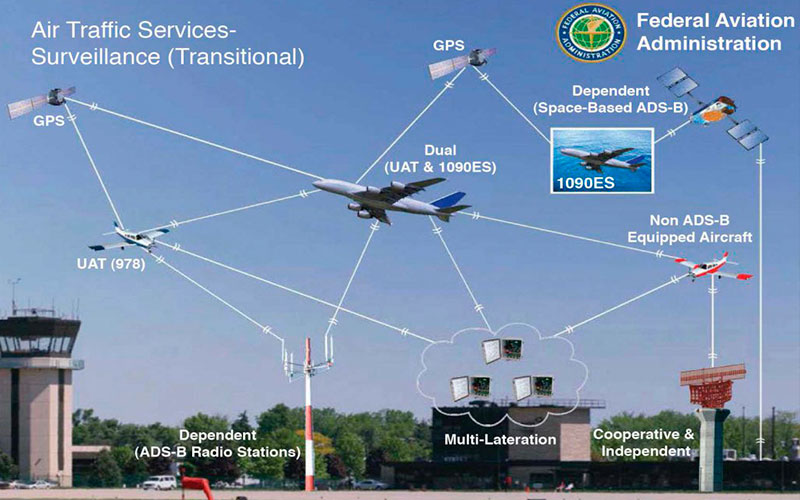What is ADS-B you ask;
- Automatic in the sense that it operates without external stimulus (unlike radar)
- Dependent in the sense that the surveillance information is derived from onboard systems
- Surveillance in the sense that it’s primarily intended to provide surveillance information to other parties
- Broadcast because it transmits to all listeners without knowing who those listeners are, there is no two-way communication
The capability of an aircraft to transmit ADS-B signals is called ADS-B OUT, the capability of an aircraft to receive ADS-B signals is called ADS-B IN. The Garmin GTX-335 is an example of an ADS-B OUT only transponder, while the GTX345 is ADS-B OUT and ADS-B IN.
ADS-B data contains information about the identity, position, altitude, and velocity of the aircraft. The position and velocity information is derived from GNSS (GPS).
ADS-B is a surveillance technology whereby the aircraft broadcasts information about its identity, position, altitude, and velocity of the aircraft to any interested party. The position and velocity information is derived from GNSS (GPS).
TCAS
ADS-B is not intended to replace TCAS, although in the future it will augment TCAS. The TCAS algorithm currently only uses distance and altitude to calculate whether there is a conflict and to determine the best conflict resolution strategy. With the more accurate ADS-B position available to the system as well, the number of TCAS interrogations can be reduced (the surveillance radio frequencies are getting congested in some areas) and the performance of TCAS can be improved. A new standard for this hybrid approach was published in 2013.
It may also be possible to have a passive TCAS-like system that does not require active interrogation but is purely depending on ADS-B. Currently, a technical standard for a new Airborne Collision Avoidance System (ACAS, the generic name for TCAS) is being developed in a joint RTCA / EUROCAE committee (RTCA SC-147 / EUROCAE WG-75), which will take advantage of more data offered by ADS-B. This new standard will eventually replace TCAS II.
ATC
The purpose of ADS-B is not to replace ground-based ATC. It will change the way ATC is done. ADS-B IN will improve the situational awareness of pilots; they will have a display of accurate positions of other aircraft. New procedures will allow pilots to maintain separation from other aircraft in marginal Visual Meteorological Conditions (VMC), where they currently would often lose sight of other traffic. More advanced usage of ADS-B will be flight deck based interval management (FIM) where ATC will be able to instruct aircraft to ‘follow that plane XX seconds behind for landing on runway YY’.
ADS-B is not a replacement for all radars, although it will allow the number of radars to be reduced. For remote areas that currently do not have radar coverage because of the associated high costs, ADS-B will be a cost-effective alternative.
The display of ADS-B IN requires a compatible cockpit monitor. The Garmin GTN series of navigators can display ADS-B targets blended with TCAS whereas older models of navigators and MFDs will only display TCAS traffic. The Garmin GTX-345 contains a built-in Bluetooth transmitter that can broadcast ADS-B traffic information to a handheld cockpit display such as an IPAD.
Canadian Maintenance Organizations (AMO’s) are approved under a bilateral agreement between the FAA and Transport Canada to complete ADS-B installations and return n-registered aircraft to service.
Rocky Mountain Aircrafts Avionics team can keep you equipped to stay airborne in 2020. Contact Us.
